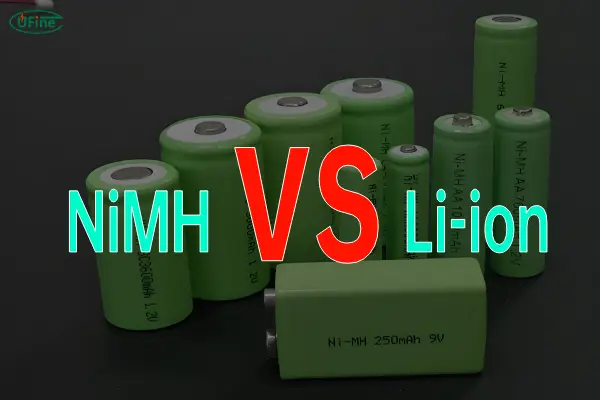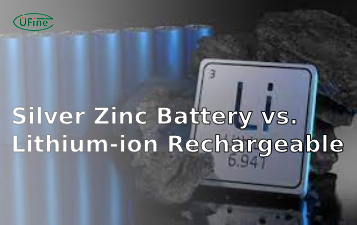
- Part 1. Energy density
- Part 2. Lifespan
- Part 3. Weight
- Part 4. Size
- Part 5. Capacity
- Part 6. Self-Discharge
- Part 7. Charging and discharging performance
- Part 8. Fast charging
- Part 9. Temperature sensitivity
- Part 10. Memory effect
- Part 11. Price
- Part 12. Application
- Part 13. Safety
- Part 14. Environmental impact
- Part 15. Maintenance
When deciding between NiMH (Nickel-Metal Hydride) and Li-Ion (Lithium-Ion) batteries, it’s important to consider how they perform in everyday use. Batteries power nearly every device we depend on, from our smartphones and laptops to household electronics and power tools. Knowing which battery type is best for your needs can save you from inconvenient replacements, performance drops, and wasted money.
In this in-depth comparison, we’ll walk through 15 essential factors, from energy density to environmental impact, helping you make an informed decision. By the end, you’ll have a clear understanding of which battery suits your lifestyle best—whether you’re powering everyday devices or looking for something more specialized.
NiMH Battery vs Li-Ion Battery vs NiCad Battery: How are they different?

Part 1. Energy density
One of the most important considerations when comparing batteries is energy density—how much energy can be stored in a given amount of space.
- Li-ion batteries shine in this category, boasting energy densities of 150-250 Wh/kg. This higher energy density allows manufacturers to produce lighter and more compact devices. Li-Ion batteries are known for having a higher energy density, often holding more energy in a smaller, lighter package. This makes them ideal for portable electronics like smartphones, laptops, and cameras, where compactness and weight matter.
- NiMH batteries typically have a lower energy density, around 60-120 Wh/kg. This means they store less energy for the same weight compared to Li-ion batteries. Though still efficient, typically have a lower energy density. This means they may not provide the same power-to-size ratio as Li-Ion batteries.
Part 2. Lifespan
Battery lifespan is crucial, especially for devices you use every day.
- Li-Ion batteries tend to last through 500 to 1,000 charge cycles, meaning they can be charged and discharged many times before their performance drops significantly. This longer lifespan often makes them a preferred choice for devices like laptops and smartphones, where replacing batteries can be costly or inconvenient.
- NiMH batteries usually last for 300 to 500 charge cycles. Although they may need replacement more often, they’re still reliable for devices that don’t require constant recharging, like household electronics.
Part 3. Weight
When it comes to weight, Li-Ion batteries offer a significant advantage.
- Li-Ion batteries are generally lighter than their NiMH counterparts, making them the go-to choice for lightweight devices like drones, smartphones, and cameras.
- NiMH batteries tend to be heavier, which may not be ideal for portable devices but is fine for applications where weight isn’t a primary concern.
Part 4. Size
Size matters, especially when space is at a premium inside devices.
- Li-Ion batteries are often more compact, which is why they’re used in electronics where every millimeter counts, such as smartphones and smartwatches.
- NiMH batteries, while available in standard sizes like AA or AAA, are generally larger than Li-Ion options for the same capacity.
Part 5. Capacity
Battery capacity, usually measured in milliampere-hours (mAh), determines how much charge a battery can hold.
- Li-Ion batteries often have higher capacity than NiMH. This translates into longer operating times between charges, which is why they’re found in high-demand devices like laptops and electric vehicles.
- NiMH batteries, while dependable, typically have lower capacities and may require more frequent recharging.
Part 6. Self-Discharge
Self-discharge is the rate at which a battery loses charge when it’s not in use.
- NiMH batteries are known to have a higher self-discharge rate, losing up to 30% of their charge per month.
- Li-Ion batteries have a much lower self-discharge rate, typically only losing around 2-3% per month.
Part 7. Charging and discharging performance
Both battery types charge and discharge effectively, but Li-Ion has the edge in performance.
- Li-Ion batteries maintain a steady voltage throughout discharge, which means the performance of your device won’t dip until the battery is almost dead.
- NiMH batteries tend to lose voltage gradually during discharge, which can lead to performance drops in devices that need consistent power, like cameras or power tools.
Real-World Experience: If you’ve ever used a Li-Ion battery in a power tool, you probably noticed that it runs at full strength until nearly depleted. With NiMH, the tool might slow down as the battery drains, affecting your productivity.
Part 8. Fast charging
Fast charging is a major advantage in today’s fast-paced world:
- Li-Ion batteries support fast charging technology, allowing you to recharge devices quickly, which is ideal for people on the go.
- NiMH batteries don’t typically support fast charging as efficiently, and charging them too quickly can result in overheating or reduced lifespan.
Part 9. Temperature sensitivity
Both batteries can be affected by temperature, but Li-Ion is more sensitive to heat:
- Li-Ion batteries are vulnerable to high temperatures, which can degrade their lifespan and even pose safety risks if exposed to heat for too long.
- NiMH batteries, while also affected by heat, tend to be more temperature-tolerant and can function better in extreme conditions.
Part 10. Memory effect
The memory effect refers to a battery’s tendency to lose capacity if it’s repeatedly recharged before being fully discharged.
- NiMH batteries are more susceptible to the memory effect, although newer versions have largely minimized this problem.
- Li-Ion batteries don’t suffer from the memory effect at all, making them more convenient for devices that get frequent partial recharges.
Part 11. Price
Price is always a factor when choosing between batteries.
- NiMH batteries are generally less expensive upfront, making them an affordable choice for household electronics like toys, flashlights, or remote controls.
- Li-Ion batteries tend to be more expensive, but they offer better performance and a longer lifespan, which can save money in the long run.
Part 12. Application
Both battery types serve different purposes:
- Li-Ion batteries are perfect for high-tech devices that require compact, powerful energy sources, such as laptops, smartphones, and electric vehicles.
- NiMH batteries work well for low-drain applications, like household gadgets, toys, and tools.
Part 13. Safety
Safety is a key consideration, especially for high-power batteries.
- Li-Ion batteries have been known to occasionally overheat or even catch fire if not properly managed, especially when damaged or exposed to extreme heat.
- NiMH batteries are generally safer and less prone to thermal runaway, though they can still overheat if improperly charged.
Part 14. Environmental impact
The environmental impact of battery disposal is an increasing concern.
- Li-Ion batteries contain toxic materials, including cobalt, which can be harmful to the environment if not properly recycled. However, Li-Ion batteries are often recyclable and have a longer lifespan, which can reduce their overall impact.
- NiMH batteries are considered more environmentally friendly, as they don’t contain heavy metals like lead or mercury. However, they tend to need more frequent replacement, which could increase waste over time.
Part 15. Maintenance
Both battery types are widely available, but their availability varies by application:
- Li-Ion batteries are virtually maintenance-free. Users simply need to keep them charged and avoid extreme temperatures. This convenience appeals to many consumers.
- NiMH batteries require regular maintenance, including checking electrolyte levels in some cases. This upkeep can be a drawback for users preferring low-maintenance solutions.
Choosing between NiMH and Li-Ion batteries boils down to your specific needs. If you need a battery with high energy density, fast charging, and longer lifespan, Li-Ion is the way to go. It’s perfect for power-hungry devices like smartphones, laptops, and electric vehicles. On the other hand, if you’re looking for a budget-friendly, environmentally-conscious option for household electronics, NiMH batteries can be a reliable choice.
By considering these 15 critical factors, you can confidently choose the battery type that best fits your lifestyle and device requirements. Whether it’s powering your next adventure or keeping your household running smoothly, making the right choice now can save you time, money, and frustration in the future.
Related Tags:
More Articles

What is the Difference Between Silver Zinc Battery vs. Lithium-ion Rechargeable?
Compare silver zinc and lithium-ion rechargeable batteries: energy density, cycle life, safety, cost, and uses in drones, medical devices, EVs, and electronics.
What are Watts and Watt Hours in Battery?
Understand watt vs watt-hour in batteries: key differences, how to calculate capacity, and why they matter. Includes free comparison table.
Best 10 Blood Pressure Monitor Battery Review: Finding the Most Reliable
Are you looking for a reliable Blood Pressure Monitor battery? Here is a complete guide with the top 10 best blood pressure monitor batteries.
Bluetooth Headphone Battery Guide: All You Need to Know
Maximize headphone battery life with expert tips! Learn how to charge, check, troubleshoot, and choose the best bluetooth headphone battery in 2025.
LiFePO4 Battery VS. Lithium-ion Polymer Battery: Which One Is Best?
Comprehensive comparison of LiFePO4 vs Lithium Ion Polymer batteries: energy density, safety, lifespan, cost. Find out which battery suits your needs in 2025.


